-
Product Overview
-
Automated EEG Analysis
- Overview
- Client Dashboard
- Clinical Dashboard
- Mini Q Brain Maps
- Full Q Brain Maps
- Protocol/Z-Score Analysis
- Supplement/Metabolic Analysis
- Narrative Analysis
-
Client Management
- Client Summary
- Physiological Profile
- Client Login Admin
-
Client Assessment
- Interactive Self Inventory
- Cognitive Emotional Checklist Maps
-
Client Engagement
- Custom Client Login Site
- Client Email Reminders
- Practitioner Email Alerts
-
Training Session Tracking
- Overview
-
Progress Tracking
- Custom Progress Trackers
-
Conclusion
- Questions?
Product Overview
The NewMind Neurofeedback Analysis System allows providers to have their clients log on and fill out questionnaires that provide information about behaviors, cognitive difficulties and emotional problems that may correlate with the EEG analysis. Practitioners can then upload EEG data and immediately generate an objective qEEG report that correlates with the subjective questionnaire data as well as the questionnaire report. These reports can be easily downloaded as an Adobe pdf file and printed out. Users are not required to maintain or update their databases as in the case where you purchase a database and the reports stored on the website automatically update in format when report improvements are made.
EEG Analysis
qEEG provides a method to take EEG recorded from a variety of locations and statistically analyze the data to provide topographical maps. This output can be used to assess clients and develop Neurofeedback protocols. Learning to process and read qEEG reports typically takes years of experience, but the NewMind Magnitude Analysis system allows users to obtain a report that is easy to interpret and use even for those with minimal experience interpreting qEEGs. This allows practitioners new to the field to begin immediately using qEEG assessment while learning the ins and outs of qEEG guided Neurofeedback as they grow as Neurofeedback providers.
The NewMind Analysis System provides a reference database system that is tailored specifically for clinicians instead of researchers. Instead of using standard deviations, the maps provide simple output indicating whether EEG is high or low in the various dimensions of analysis. The cognitive output automatically flags areas of possible problems based on correlations between map output and MRI research. Emotional output information provides similar information based on MRI research and standard neurology texts, as well as clinical experience. Clinicians can see, at a glance, the salient issues likely to be present due to the EEG distribution as well as being provided with an appropriate protocol option.

Cient Dashboard
A simplified Dashboard specifically designed for the clinician to share with clients is provided. One head is presented indicating the areas with the greatest aggregate deviance measures. A meter presenting overall cognitive efficiency is provided, which reflects the cumulative functional consequence of a variety of key cognitive dimensions. In addition, individual meters are provided for measures of over-arousal, inhibition, and under-arousal levels.
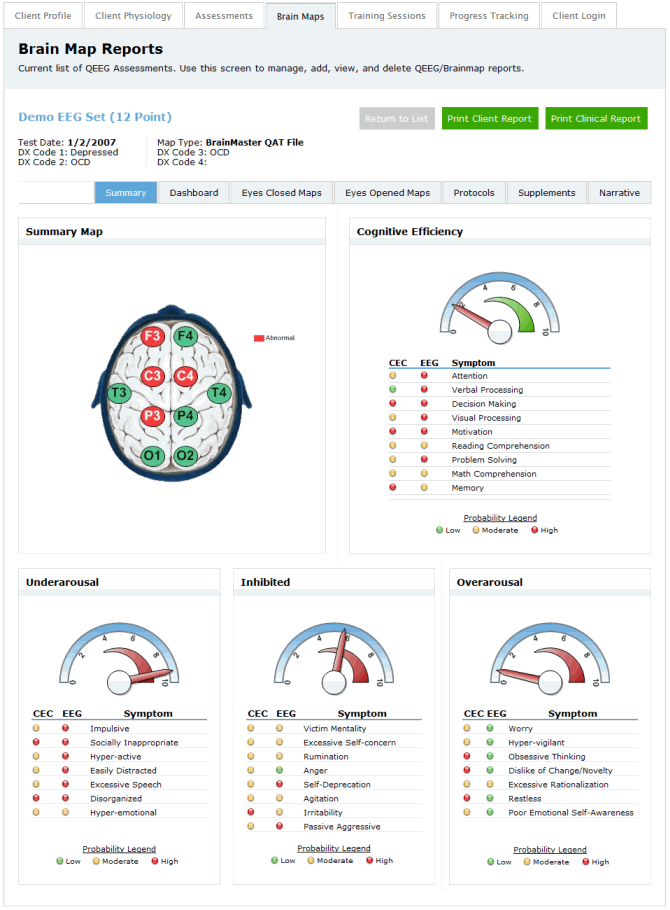
Clinical Dashboard
Probabilities of possible emotional issues are identified by a three level probability light system. A green light indicates the particular emotional dimension was not identified in the client's brain map (EEG) data, a yellow light indicates a slight probability, and a red light indicates a strong probability that the specific emotional problem is detected from the brain map (EEG) data. These lights are correlated with a second set of lights, presented alongside the first set, derived from related questions endorsed by clients using a Likert-like questionnaire completed on the website.
Cognitive issues that are detected from the Brain Map (EEG) data patterns and reported by the client in the Presenting Symptoms questionnaire are identified with an additional column of lights using the same color coding system to indicated a match between the two.
Easy to read gauges display probabilities of problems with Cognitive Efficiency, Underarousal (ADHD type features), Inhibition (depressive type feature) and Overarousal (anxiety type features). Gauges are also provided for more specific analysis of component features contributing to dimensions of Executive Function, Memory Processing, Auditory Processing and Visual Processing.

Mini Q Brainmaps
The New Mind automated EEG analysis is available in easy to read Mini Q 12 or 19 point topological brain maps. Collected by serial acquisition, these maps are presented in the standard component bands for Magnitude, Dominant Frequency, Coherence,Phase and Asymmetry. An additional Subcomponent Analysis section displaying generalized distribution for purposes of training filter settings is also provided. Practitioners using two or four channel Brainmaster or BioExplorer based equipment can easily make high quality professional maps that provide sophisticated in depth analysis of EEG distribution patterns.
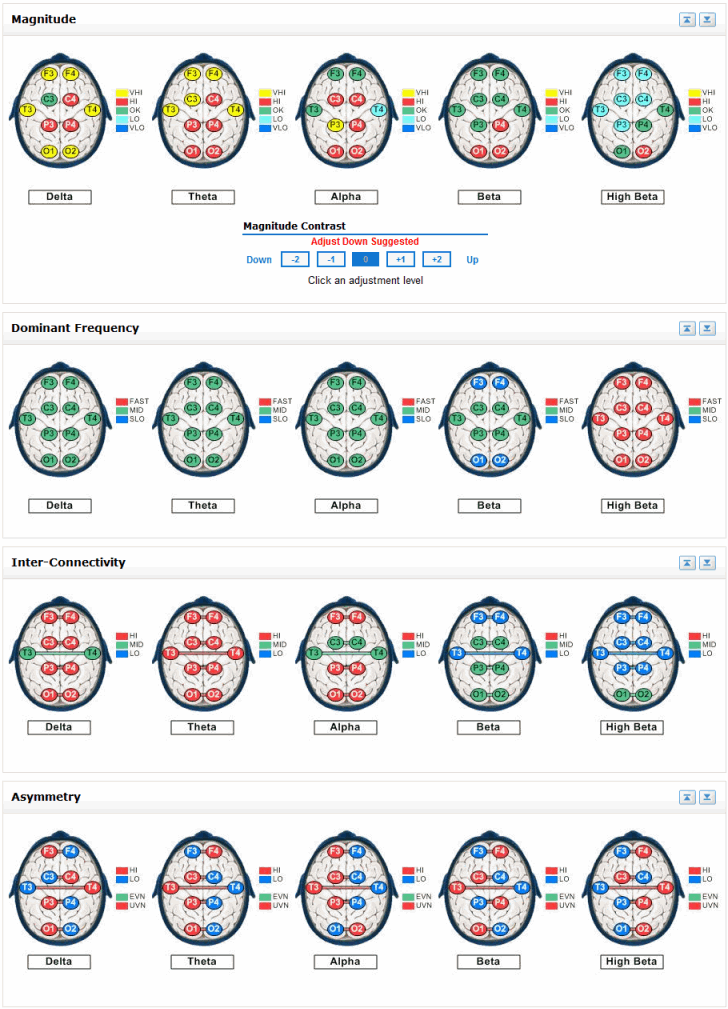
Full Q Brainmaps
Simultaneous 19 channel acquisition systems can upload EDF data files to the map site and edit out artifacts to generate high quality professional maps that can be used for analysis and reports that can be easily downloaded in .pdf format. The downloaded reports provide quick and easy to read standardized narrative reports with dashboards that highlight key findings.
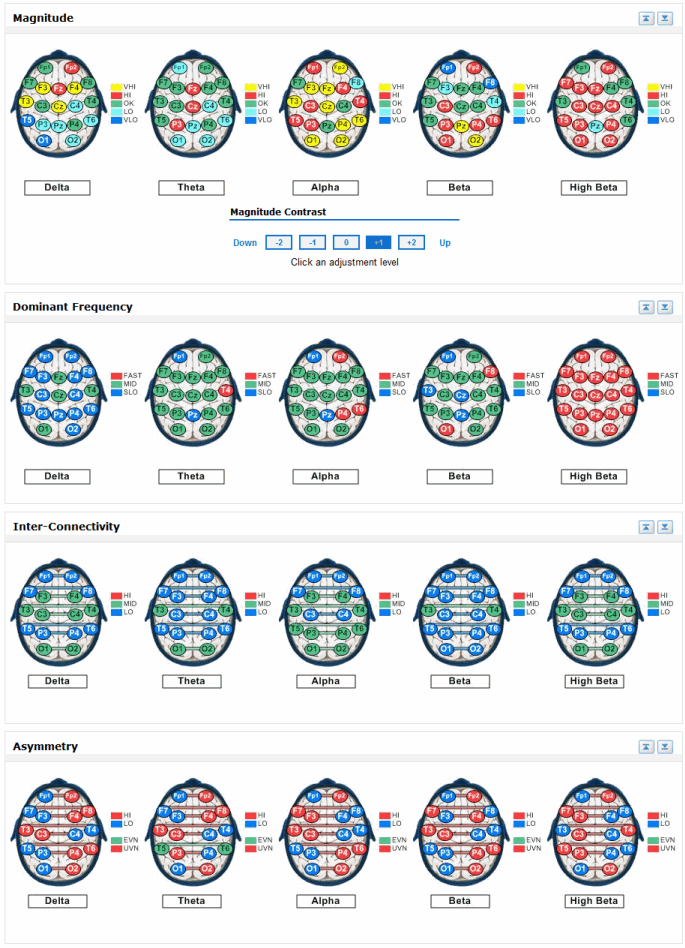
Automated Protocol Analysis
The NewMind automated EEG analysis produces a set of suggested protocols, derived from detected patterns in the Brain Map (EEG) data. These protocols are developed by Dr. Richard Soutar from years of clinical nuerofeedback experience. Both single and two-channel protocol suggestions are given to suit any desired protocol assessment.
The NewMind automated EEG analysis also identifies primary and secondary Z-Score locations. The Z-Score location suggestions assist the practitioner in identifying the locations to use when Z-Score protocol Neurofeedback training is being used. Finding Z-Score locations and their order can be a long and painful process, the NewMind Z-Score analysis helps simplify and speed up this analysis process.

Supplement Analysis
The NewMind automated EEG analysis produces a list of suggested supplements that the client may want to consider, based on detected patterns presented in the Brain Map (EEG) data.
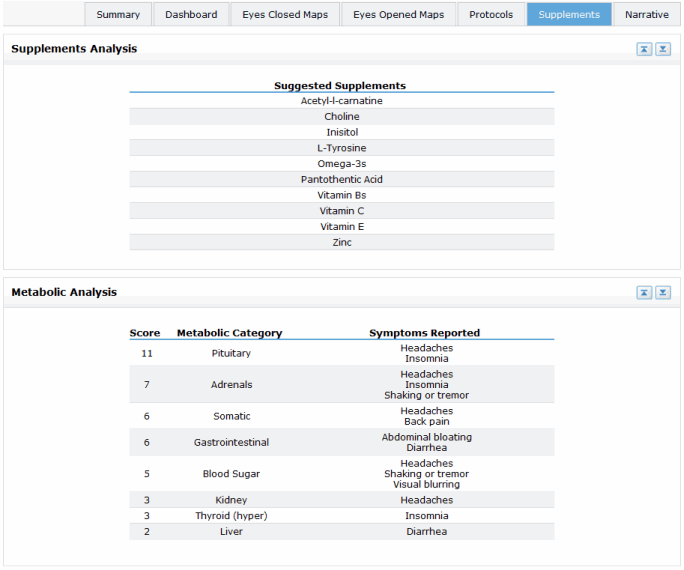
Narrative Analysis
The NewMind automated EEG analysis produces a full written narrative report based on the QEEG and CEC findings.
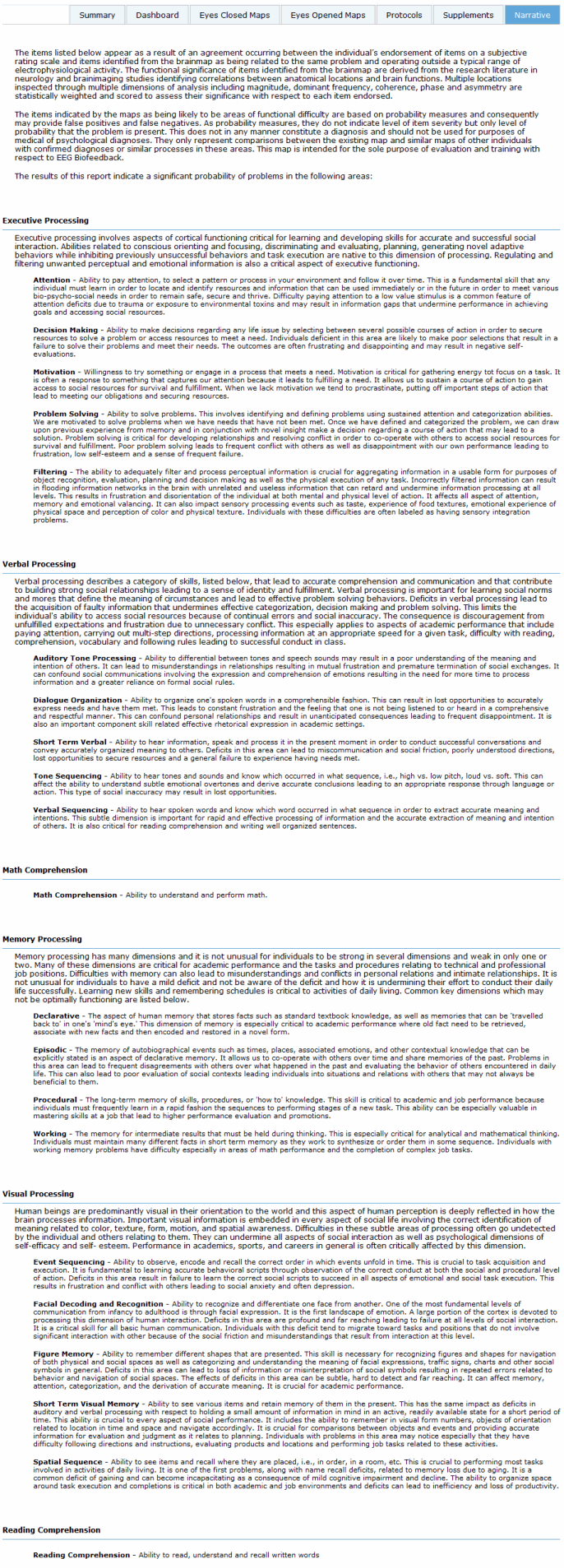
Client Summary
The NewMind client management system provides an easy, at a glace method of managing your clients. From one screen you can view/update client information, client medication/supplement background profile, client physiological profile, add client assessment questionnaires, manage EEG Brain maps, design training protocols, track training session details, build custom progress trackers to track your client's progress in neurofeedback, and much more. Store all information and details related to you clients and their neurofeedback experience in one easy to access and review location.
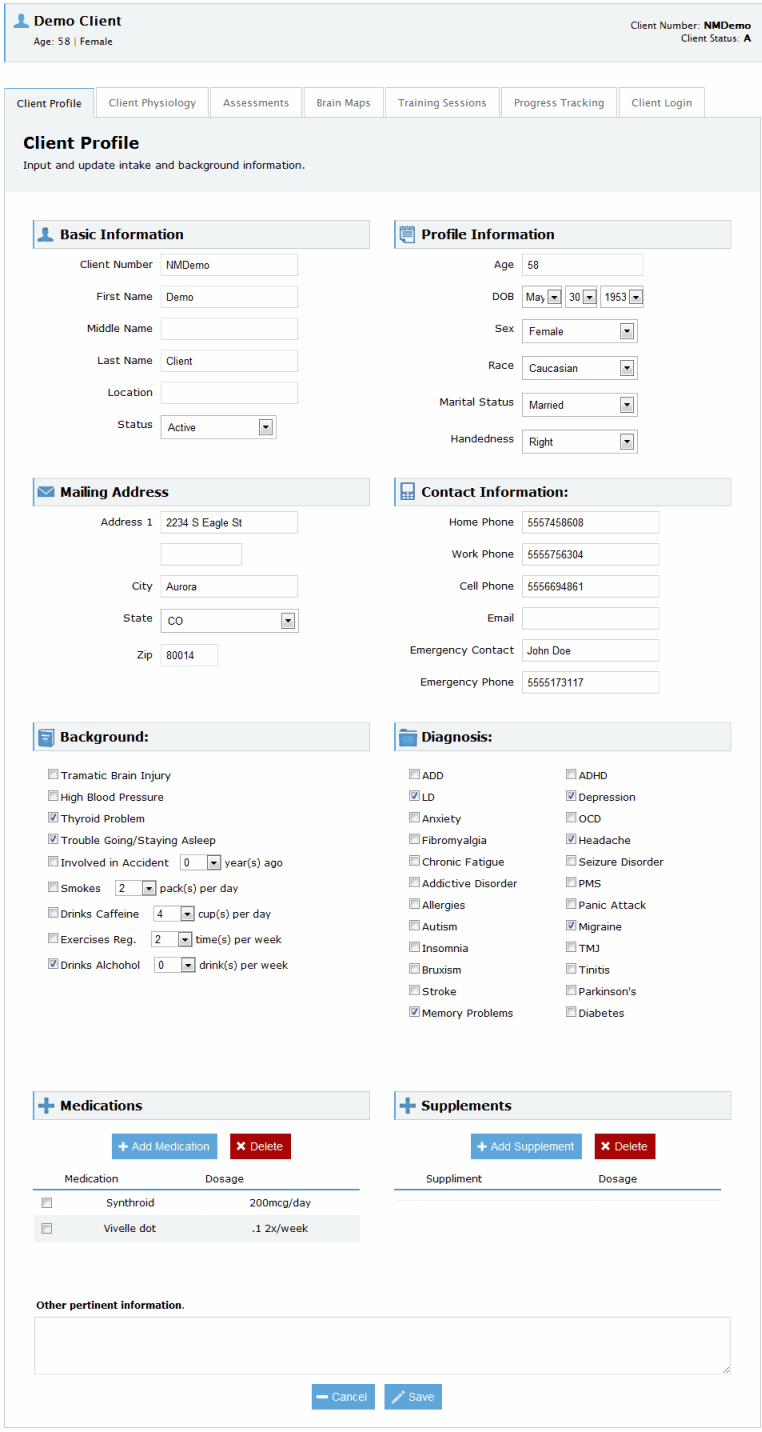
Client Physiological Profile
The NewMind Client management system provides an easy at a glace method of building and viewing a client's physiological profile. Only physiological problems reported by the client are in bold, making review a cinch. The client's physiological profile is a power tool to use in the overall assessment of a client.
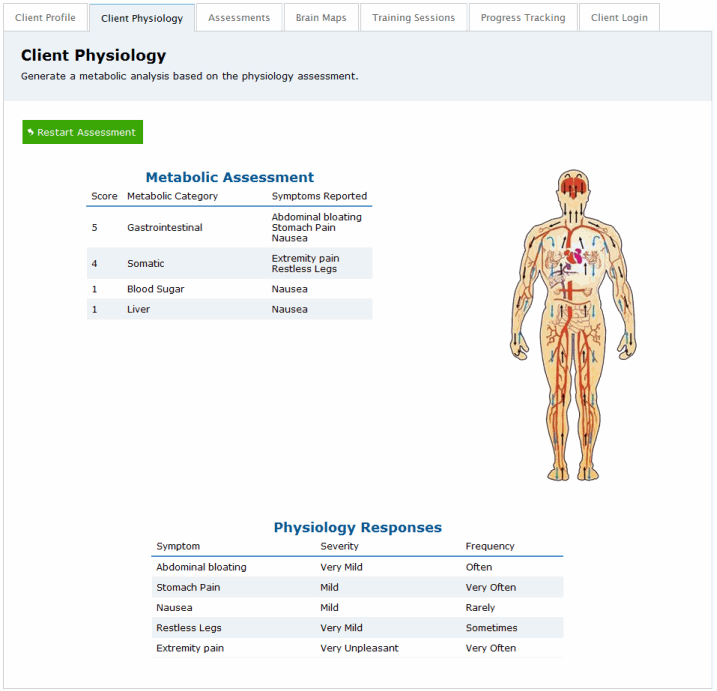
Client Login
Practitioner's clients can log on to https://www.my-newmind.com
There, the client can update their information, complete progress questionnaires, and submit client analyses.
This gives the client a sense of involvement and engages them more in the neurofeedback and healing process.
The practitioner can have a complete profile and predictive brain map of the client before their first appointment by having prospective clients login from home and fill in their client information, medication/supplement and medical background, build their physiological profile, and complete the client assessment questionnaires. The provider can then have an initial assessment of the client and a rough plan of action on their very first visit to the office. This greatly reduces administration workloads, moves clients through the office quicker, and gets the client involved and motivated from day one.
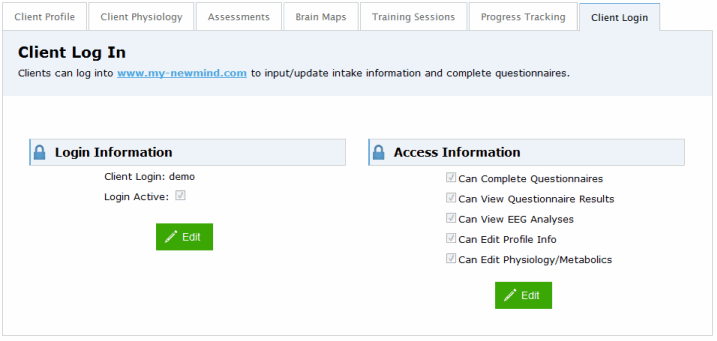
Interactive Self Inventory
The Interactive Self Inventory test is a statistically validated instrument based on social psychological dimensions of behavior, many of which correlate with EEG distribution. Practitioners can have clients fill out the questionnaire and acquire an output graph indicating potential problem areas of social interaction that are contributing to the clients problematic social behavior, and which are likely to interfere with the neurofeedback process. The approach and avoidant dimensions often correlate with alpha and beta asymmetry while the impulsivity dimension often correlates with theta distribution and is highly correlated with TOVA performance. Anxiety and depression dimensions correlate closely with the Beck inventories as well as EEG distributions. Problem areas can be addressed using the provided 'Guides To Change.'
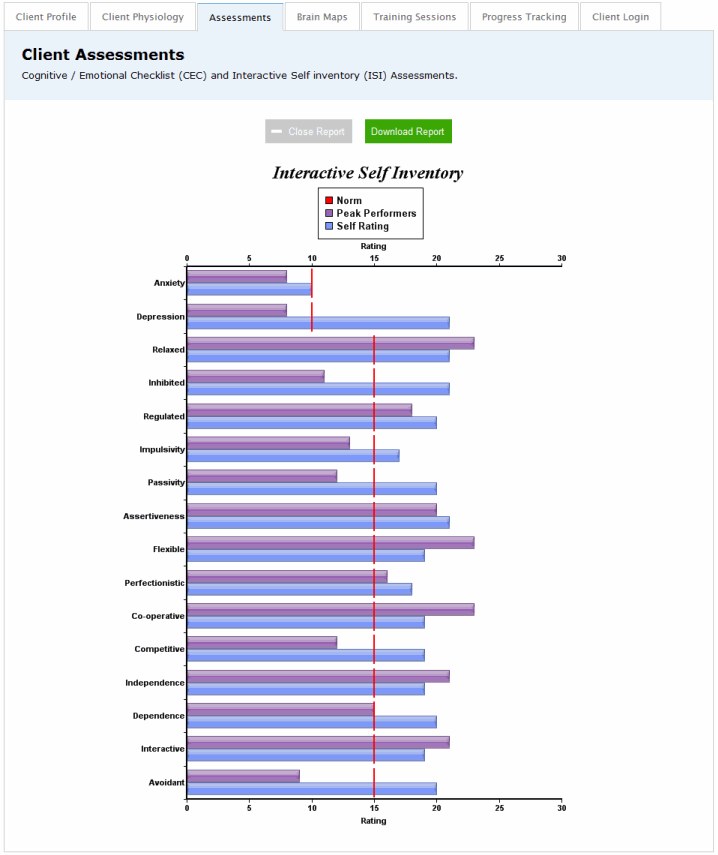
Cognitive Emotional Checklist - Predictive Brain Map
The Cognitive Emotional Checklist reports provide an opportunity for neurofeedback practitioners to have their clients go through a list of common cognitive and emotional problems and check off the intensity level of each problem. Using the research from MRI studies, the program will produce qEEG map heads that indicate what areas might be involved in these problems. There is one head that predicts problem areas involving slow wave activity and one head that predicts problem areas involving fast waves. Practitioners can then compare these maps to the miniQ maps and look for correlations. In the future the program will do this automatically and indicate where the two measures converge.
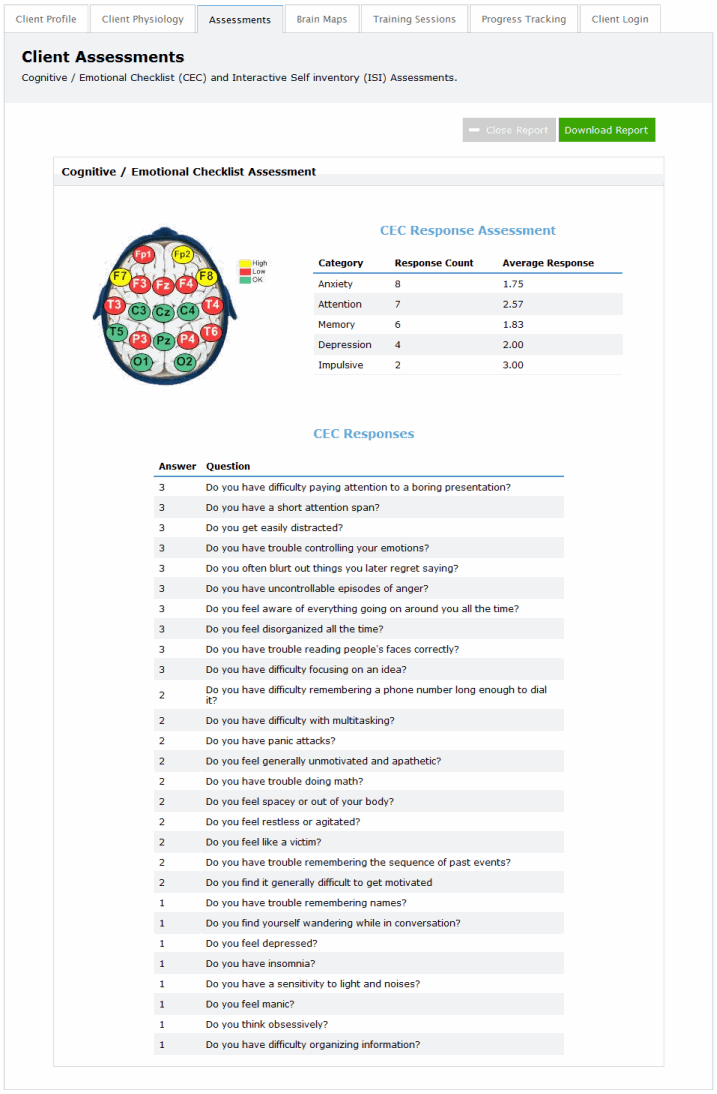
Separate Customizable Client Login Site Included
The New Mind Client management system includes a separate client login site at https://www.my-newmind.com. This site can be customized with the practitioner's business logo, so clients think they are at the providers website and do not get confused seeing another companies name.
Automated Client Email Reminders *Coming Soon*
Set up custom email reminders for your clients to remind them to complete client assessment and progress tracker questionnaires. It is easy for clients to forget to complete the questionnaires and a gentle email reminder can remind the client to login from home and complete the questionnaires assigned to them.
Automated Practitioner Email Alerts
As clients login and complete client assessment and progress tracker questionnaires, the completed analyses are instantly available for the provider to review in the client's account. As clients complete questionnaires, an email alert can also be sent to the provider letting them know the client has completed the assigned task.
Session Tracking
Tracking neurofeedback training sessions has never been easier. Providers can keep all training session details, results, and notes in one centralized location. Imagine having all of the training history details of a client on one screen, making finding and reviewing the entire training history of a client fast, easy, and seamless.
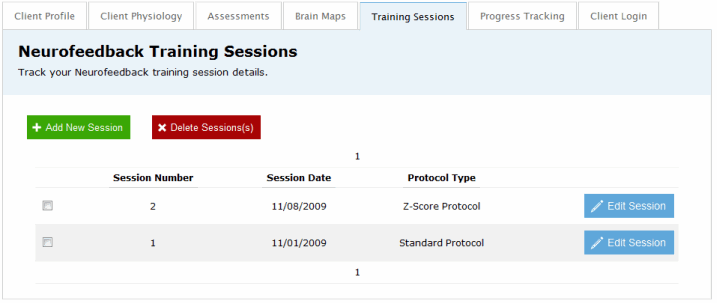
Custom Built Progress Trackers
Providers know that all clients are different and have different challenges that they may be facing. The symptom checklist does not cover all possible symptoms that a provider may want to track for a given client. The New Mind Analysis system provides practitioners the ability to build custom progress trackers from over 150 different symptoms to suit their client's needs. Multiple progress trackers can be created for clients to accommodate any progress tracking regimen imaginable. Practitioners can create multiple progress trackers to be completed by separate people in the client's life (i.e. one for the client, one for the parent, one for the spouse, etc.). Clients can then login from home and complete the various progress trackers assigned to them by the provider. This engages the client as well as providing the practitioner an easy way to track the client's progress for later review with the client. The PDF report graph types are also customizable, allow the provider to tailor fit the report to the client and the client's needs.
![]()
![]()
Thank You
Thank you for taking the NewMind product tour and we hope the information provided has been both informative and insightful.
If you have any additional questions regarding the features or functionality of the system, please contact us today:
Email: Support@NewMindMaps.com.